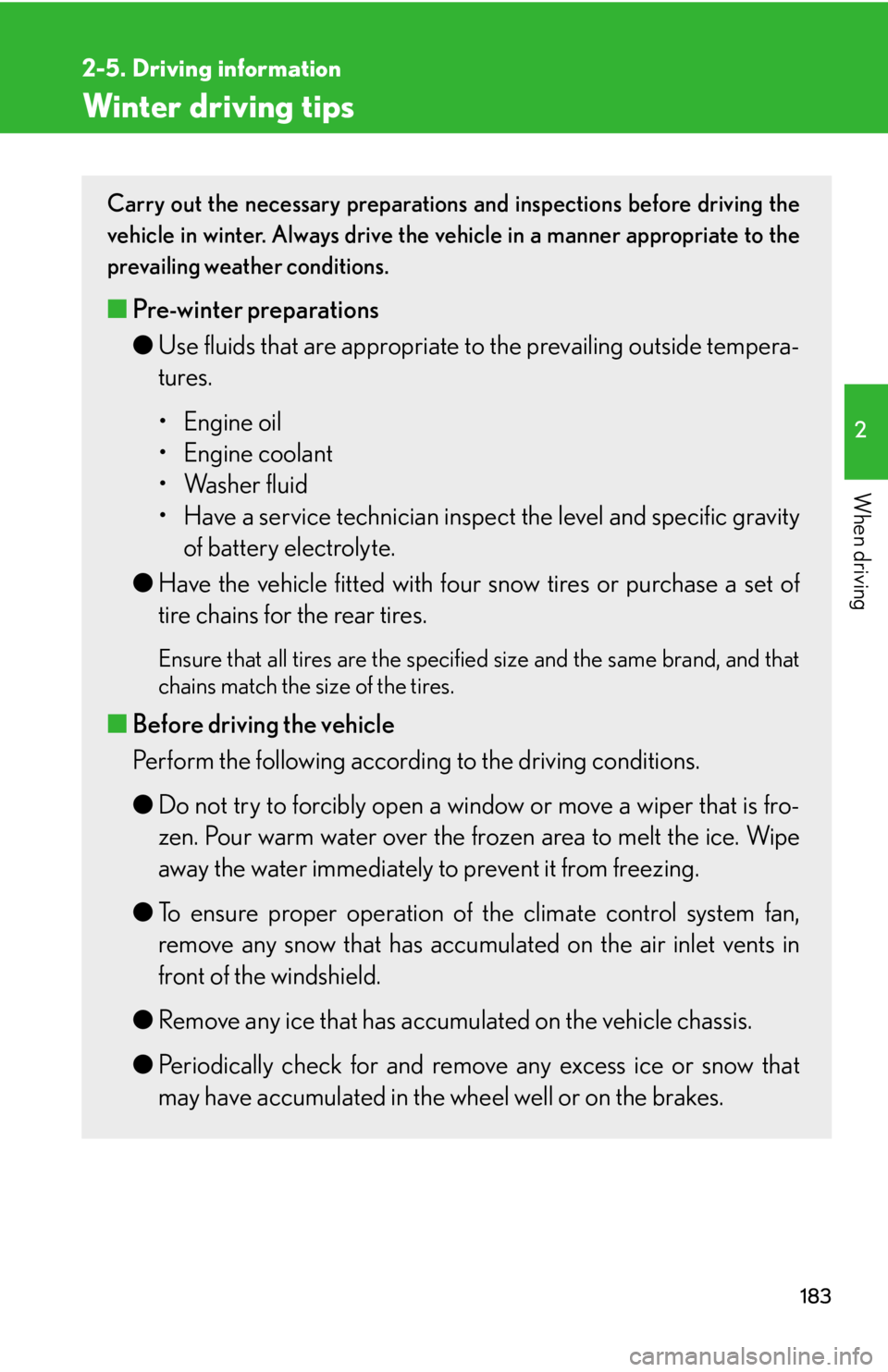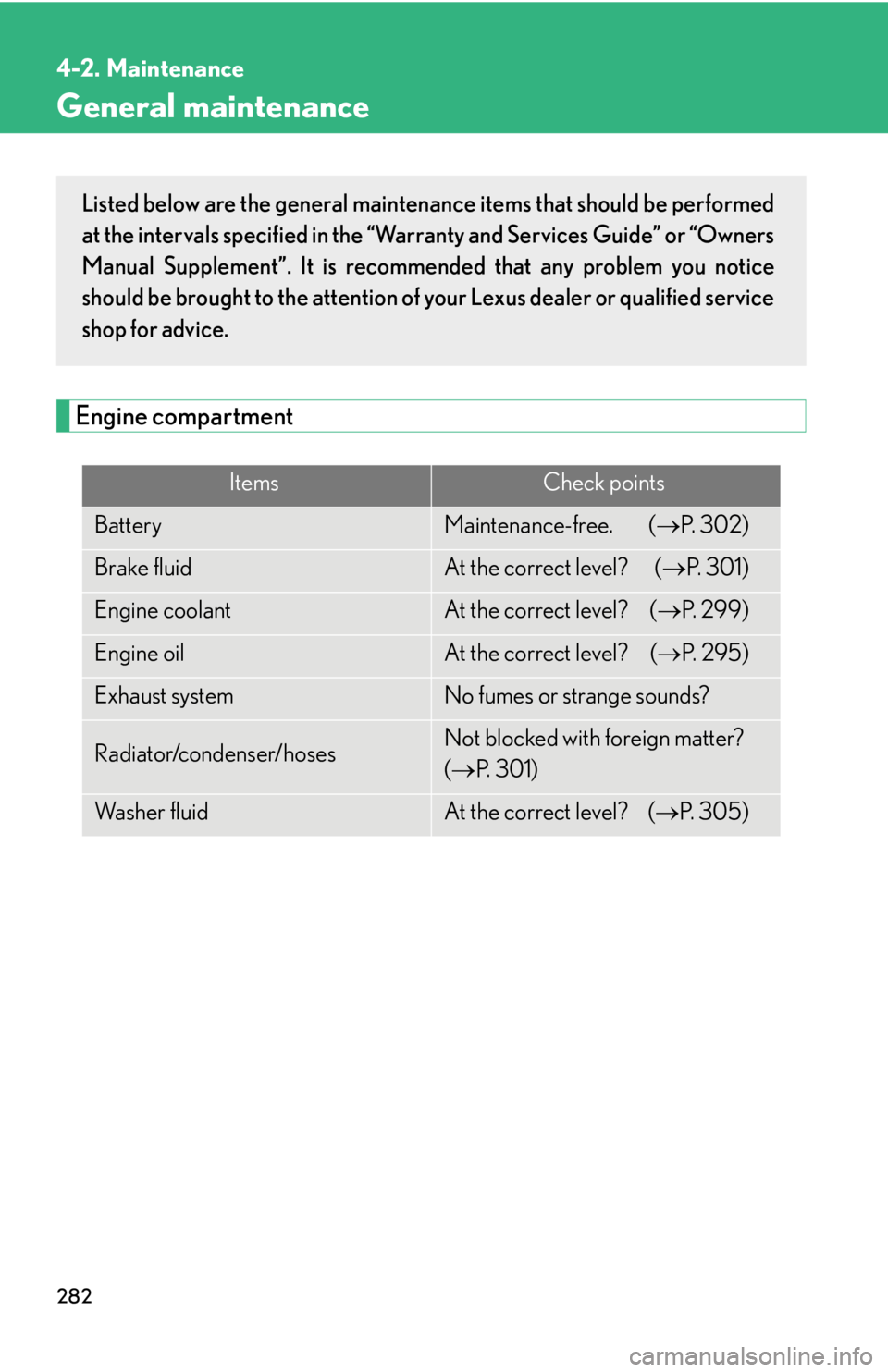check oil Lexus IS250 2008 Using the air conditioning system and defogger / LEXUS 2008 IS250 OWNER'S MANUAL (OM53699U)
[x] Cancel search | Manufacturer: LEXUS, Model Year: 2008, Model line: IS250, Model: Lexus IS250 2008Pages: 464, PDF Size: 6.61 MB
Page 116 of 464

116
2-1. Driving procedures
NOTICE
■If you hear a squealing or scraping noise (brake pad wear limit indicators)
Have your Lexus dealer check and replac e the brake pads as soon as possible.
The rotor damage can result if the pads are not replaced when needed.
Front brake only: Moderate levels of the brake pad and disc wear allow enhanced
front braking power. As a result, the disc s may wear more quickly than conventional
brake discs. Therefore, when replacing the brake pads, Lexus recommends that you
also have the thickness of the discs measured.
It is dangerous to drive the vehicle when the wear limits of the brake pads and/or
that of the brake discs are exceeded.
■If you get a flat tire while driving
A flat or damaged tire may cause the following situations. Hold the steering wheel
firmly and gradually press the brak e pedal to slow down the vehicle.
●It may be difficult to control your vehicle.
●The vehicle will make abnormal sounds.
●The vehicle will behave abnormally.
Replace a flat tire with a new one. ( P. 3 8 4 )
■When encountering flooded roads
Do not drive on a road that has flooded after heavy rain etc. Doing so may cause the
following serious damage to the vehicle.
●Engine stalling
●Short in electrical components
●Engine damage caused by water immersion
In the event that you drive on a flooded road and the vehicle is flooded, be sure to
have your Lexus dealer check the following.
●Brake function
●Changes in quantity and quality of oil an d fluid used for the engine, transmission,
differential, etc.
●Lubricant condition for the propeller shaft, bearings and suspension joints (where
possible) and the function of all joints, bearings, etc.
Page 183 of 464

183
2-5. Driving information
2
When driving
Winter driving tips
Carry out the necessary preparations and inspections before driving the
vehicle in winter. Always drive the vehicle in a manner appropriate to the
prevailing weather conditions.
■ Pre-winter preparations
●Use fluids that are appropria te to the prevailing outside tempera-
tures.
• Engine oil
• Engine coolant
• Washer fluid
• Have a service technician inspect the level and specific gravity
of battery electrolyte.
● Have the vehicle fitted with four snow tires or purchase a set of
tire chains for the rear tires.
Ensure that all tires are the specified size and the same brand, and that
chains match the size of the tires.
■ Before driving the vehicle
Perform the following according to the driving conditions.
● Do not try to forcibly open a w indow or move a wiper that is fro-
zen. Pour warm water over the frozen area to melt the ice. Wipe
away the water immediately to prevent it from freezing.
● To ensure proper operation of the climate control system fan,
remove any snow that has accumu lated on the air inlet vents in
front of the windshield.
● Remove any ice that has accumul ated on the vehicle chassis.
● Periodically check for and remove any excess ice or snow that
may have accumulated in the wheel well or on the brakes.
Page 282 of 464

282
4-2. Maintenance
General maintenance
Engine compartment
ItemsCheck points
BatteryMaintenance-free. (P. 3 0 2 )
Brake fluidAt the correct level? ( P. 3 0 1 )
Engine coolantAt the correct level? ( P. 2 9 9 )
Engine oilAt the correct level? ( P. 2 9 5 )
Exhaust systemNo fumes or strange sounds?
Radiator/condenser/hosesNot blocked with foreign matter?
( P. 3 0 1 )
Wa s h e r f l u i dAt the correct level? ( P. 3 0 5 )
Listed below are the general maintenance items that should be performed
at the intervals specified in the “War ranty and Services Guide” or “Owners
Manual Supplement”. It is recomme nded that any problem you notice
should be brought to the attention of your Lexus dealer or qualified service
shop for advice.
Page 295 of 464

295
4-3. Do-it-yourself maintenance
4
Maintenance and care
Engine oilWith the engine at operating temperat ure and turned off, check the oil
level on the dipstick.
■ Checking the engine oil
Park the vehicle on level ground . After turning off the engine, wait
a few minutes for the oil to drain back into the bottom of the
engine.
Hold a rag under the end and pull
the dipstick out.
Wipe the dipstick clean.
Reinsert the dipstick fully.
Holding a rag under the end, pull the dipstick out and check the
oil level.
Wipe the dipstick and reinsert it fully.
Low
Full
STEP1
STEP2
STEP3
STEP4
STEP5
STEP6
Page 296 of 464

296
4-3. Do-it-yourself maintenance
■Adding engine oil
If the oil level is below or near the
low level mark, add engine oil of
the same type as already in the
engine.
Make sure to check th e oil type and prepare the items needed before
adding oil.
Remove the oil filler cap.
Add engine oil slowly, checking the dipstick.
Install the filler cap, turning it clockwise.
It takes about 1.6 qt. (1.5 L, 1.3 lmp.qt.) to raise the oil level from low to full on the
dipstick.
Oil gradeILSAC multi-grade engine oil
ItemsClean funnel
STEP1
STEP2
STEP3
Page 299 of 464

299
4-3. Do-it-yourself maintenance
4
Maintenance and care
Engine coolantThe coolant level is satisfactory if it is between the “FULL” and “LOW”
lines on the reservoir when the engine is cold.
Reservoir cap
“FULL”
“LOW”
If the level is on or below the
“LOW” line, add coolant up to the
“FULL” line.
NOTICE
■To prevent serious engine damage:
Check the oil level on regular basis.
■When replacing the engine oil
●Be careful not to spill engine oil on the vehicle components.
●Avoid overfilling, or the engine could be damaged.
●Check the oil level on the dipstick every time you refill the vehicle.
●Be sure the engine oil filler cap is properly tightened.
Page 375 of 464

5
When trouble arises
375
5-2. Steps to take in an emergency
Wa r n i n g m e s s a g eDetailsCorrection procedure
Indicates that engine oil
level is low.Check the level of engine
oil, and add if necessary.
(U.S.A. only)
Indicates that the engine
oil is scheduled to be
changed.
Check the engine oil, and
change if necessary.
Comes on approximately
4500 miles (7200 km)
after the engine oil is
changed. (The indicator
will not work properly
unless the oil mainte-
nance data has been
reset.)
(U.S.A. only)
Indicates that the engine
oil should be changed.
Check and change the
engine oil.
Comes on approximately
5000 miles (8000 km)
after the engine oil is
changed (and the oil
maintenance data has
been reset).
Page 388 of 464

388
5-2. Steps to take in an emergency
CAUTION
■Using the tire jack
Improper use of the tire jack may lead to death or injuries due to the vehicle sud-
denly falling off the jack.
●Do not use the tire jack for any purpose other than replacing tires or installing and
removing tire chains.
●Only use the tire jack that comes with this vehicle for replacing a flat tire.
Do not use it on other vehicles, and do not use other tire jacks for replacing tires
on this vehicle.
●Always check that the tire jack is securely set to the jack point.
●Do not put any part of your body under the vehicle supported by a jack.
●Do not start or run the engine while your vehicle is supported by the jack.
●Do not raise the vehicle while someone is in it.
●When raising the vehicle, do not put an object on or under the jack.
●Do not raise the vehicle to a height greate r than that required to replace the tire.
●Use a jack stand if it is necessary to get under the vehicle.
Take particular care when lowering the vehicle to ensure that no one working on or
near the vehicle may be injured.
■Replacing a flat tire
Observe the following precautions to reduce the risk of death or serious injury.
●Never use oil or grease on the wheel bolts or wheel nuts.
The oil or grease can cause the wheel nuts to loosen, causing a serious accident.
Remove any oil or grease on the wheel bolts or wheel nuts.
●Have the wheel nuts tightened with a torque wrench to 76 ft•lbf (103 N•m, 10.5
kgf•m) as soon as possible after changing wheels.
Failure to follow these precautions could cause the nuts to loosen and the wheels
may fall off, which could lead to an accident causing death or serious injury.
Page 412 of 464

412
6-1. Specifications
Electrical system
Differential
*: “Toyota Genuine Differential gear oil LT” is filled in your Lexus vehicle at fac-tory fill. Use Lexus approved “Toyota Genuine Differential gear oil LT” or an
equivalent of matching quality to satisf y the above specification. Please contact
your Lexus dealer for further details.
Battery
Open voltage* at
68 F (20 C):12.6 12.8 V Fully charged
12.2
12.4 V Half charged
11.8
12.0 V Discharged
(*: Voltage checked 20 minutes after
the engine and all the lights are turned
off)
Charging rates5 A max.
Oil capacity
Front0.74 qt. (0.70 L, 0.61 lmp.qt.)
Rear
IS350:
1.42 qt. (1.35 L, 1.19 lmp.qt.)
IS250 (2WD models): 1.20 qt. (1.15 L, 1.01 lmp.qt.)
IS250 (AWD models): 1.10 qt. (1.05 L, 0.92 lmp.qt.)
Oil type and
viscosity*
IS250 (AWD)
Hypoid gear oil API GL-5 Above 0 F (-18 C): SAE90
Below 0 F (-18 C): SAE80W
or SAE80W-90
Others
“Toyota Genuine Differential
Gear Oil LT 75W-85 GL-5” or
equivalent
Page 453 of 464

453
Alphabetical index
Electric power steering ....................... 170
Electronic keyIf the electronic key does not operate properly ............................ 394
Emergency, in case of If the engine will not start ................. 391
If the shift lever cannot be shifted from P ................................... 392
If the vehicle has discharged battery.................................................. 397
If the warning buzzer sounds...... 360
If the warning light turns on .......... 360
If the warning message is displayed ............................................ 369
If you have a flat tire ........................ 382
If you lose your keys ........................ 393
If you think something is wrong................................................... 356
If the electronic key does not operate properly ............................ 394
If your vehicle becomes stuck .... 402
If your vehicle needs to be towed ...................................................350
If your vehicle overheats................400 Engine
Compartment...................................... 292
Engine switch .......................................... 117
Hood ....................................................... 289
How to start the engine ..................... 117
Identification number .......................407
If the engine will not start................. 391
Ignition switch ......................................... 117
Overheating ........................................ 400
Engine compartment cover ............. 294
Engine coolant Capacity .................................................... 411
Checking ...............................................299
Preparing and checking before winter ..................................... 183
Engine coolant temperature gauge....................................................... 130
Engine immobilizer system.................. 72
Engine oil Capacity .................................................. 410
Checking ...............................................295
Preparing and checking before winter ..................................... 183
Engine oil maintenance data............298
EPS .............................................................. 170
Event data recorder ........................... 358E